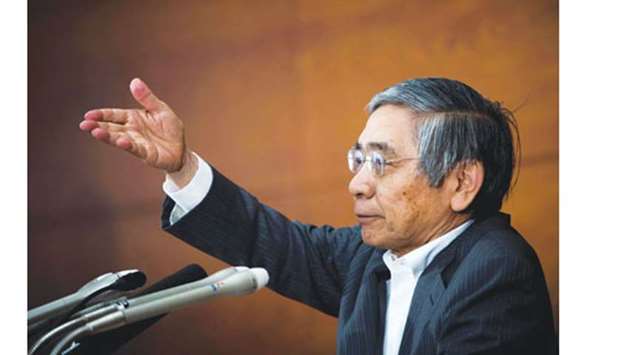But governor Haruhiko Kuroda reassured markets the BoJ will still lag well behind the Federal Reserve in dialling back its massive stimulus programme, with inflation far from reaching his 2% target.
He also shrugged off the need to scrap the BoJ’s pledge to increase its bond holdings at ¥80tn ($729bn) per year, even though recent purchases have slowed significantly.
“There’s some distance to achieving 2% inflation, so it’s inappropriate to say now specifically how we will exit our ultra-loose monetary policy, and how that could affect the BoJ’s financial health,” Kuroda told a news conference.
“We will debate an exit strategy only after 2% inflation is achieved and price growth stays there stably.”
As widely expected, the BoJ maintained its pledge to guide short-term interest rates at minus 0.1% and the 10-year government bond yield around zero under its yield curve control (YCC) programme.
Relishing recent bright signs in the economy, the central bank upgraded its view on private consumption for the first time since December 2016 to say it has shown “increased resilience.”
That was a more upbeat view than the previous meeting in April, when it said spending was resilient. The BoJ revised up its assessment of global growth and reiterated its optimistic view that Japan’s economy was heading for a moderate expansion.
“The BoJ has grown confident on the economy, although it is fully aware inflation remains low despite a tightening labour market,” said Izuru Kato, chief economist at Totan Research.
“Unless inflation accelerates unexpectedly, the BoJ will likely stand pat on policy at least until next April when Kuroda serves out his current term.”
Consumption has been a soft spot in Japan’s otherwise strengthening economy, with its weakness blamed for keeping inflation subdued by discouraging companies from raising prices.
Growing signs of life in Japan’s economy have presented a fresh communication challenge for the BoJ, pushing it to be clearer with markets on how it might withdraw its stimulus – without sounding as if such an action is imminent.
Inflation remains disappointingly low, making BoJ officials wary of releasing too much detail on how the bank may exit its ultra-loose policy in the future.
Kuroda conceded that it was taking longer than expected to achieve his inflation target because prolonged periods of deflation have accustomed the public to acting on the assumption that inflation and wage growth won’t accelerate. But he shrugged off calls from critics of his radical stimulus programme to abandon the BoJ’s 2% inflation target or dial back monetary support.
“I know there are various discussions on the pros and cons of prolonged easing.
But what’s most important is to achieve price stability and maintain it,” Kuroda said.
He also rebuffed the view the BoJ ought to slow purchases of exchange-traded funds (ETF), which it accelerated last year to fend off damage from the market disruption caused by Britain’s decision to leave the European Union.
“We don’t buy these assets to manipulate stock prices to a certain level.
We buy them to achieve our 2% inflation target at the earliest date possible,” Kuroda said.
After years of heavy money printing failed to drive up prices, the BoJ last year added YCC to its massive asset-buying programme, under which it buys government bonds and risky assets such as ETFs.
While it now targets interest rates instead of the pace of money printing, the BoJ has maintained a loose pledge to increase its bond holdings at ¥80tn per year to appease proponents of aggressive asset purchases on its board.
But with this prodigious buying drying up market liquidity, the BoJ has slowed its bond purchases considerably in recent months.
Analysts expect the BoJ to slow its buying to around ¥60tn by year-end and omit the ¥80tn pledge from its policy statement.
Kuroda, however, said he saw no reason to remove the pledge because the pace of bond buying could fluctuate from time to time.
“The amount we buy would be determined based on how much is necessary to guide interest rates appropriately,” he said.



